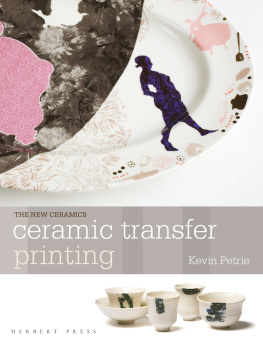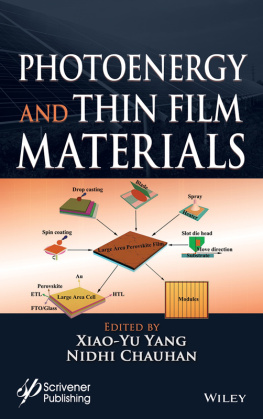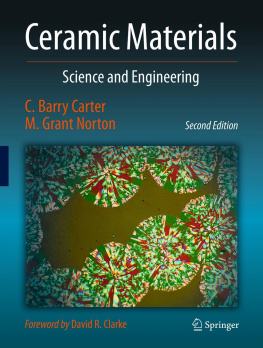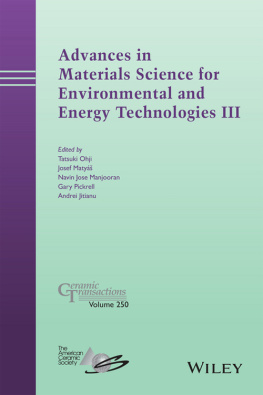Thin-Section Petrography
of
Ceramic Materials
INSTAP ARCHAEOLOGICAL EXCAVATION MANUAL 2
Thin-Section Petrography
of
Ceramic Materials
INSTAP ARCHAEOLOGICAL EXCAVATION MANUAL 2
by
Sarah E. Peterson
with contributions by
Philip P. Betancourt
Published by
INSTAP Academic Press
Philadelphia, Pennsylvania
2009
Design and Production by
INSTAP Academic Press
Philadelphia, PA, USA
Cover photo after Day and Relaki 2003, pl. 2C, sample no. 95/62.
Library of Congress Cataloging-in-Publication Data
Peterson, Sarah E., 1983-
Thin-section petrography of ceramic materials / by Sarah E. Peterson ; with contributions by
Philip P. Betancourt.
p. cm. -(INSTAP archaeological excavation manual ; v. 2)
Includes bibliographical references.
ISBN 978-1-931534-55-0 (alk. paper)
eISBN 978-1-623031-28-2 (epub)
Mobi ISBN 978-1-623031-28-2 (kindle)
1. Petrology in archaeology. 2. Ceramics--Analysis. I. Betancourt, Philip P., 1936-II. Title.
CC79.P4P46 2009
552'.06--dc22
2009017409
Copyright 2009
INSTAP Academic Press
Philadelphia, Pennsylvania
All rights reserved
List of Figures
Figure 1. Photomicrograph of a thin section of a coarse vessel from Mochlos in cross-polarized light showing large, weathered phyllite inclusions (after Day and Relaki 2003, pl. 1A, sample no. 95/50). Horizontal dimension = 4 mm.
Figure 2. Eleni Nodarou using a petrographic microscope to study thin sections of pottery at the Institute for Aegean Prehistory Study Center for East Crete, Pacheia Ammos, Crete, Greece. Photo by Chronis Papanikolopoulos.
Figure 3. Eleni Nodarou using a non-deformational diamond saw in the William A. McDonald Petrography Laboratory at the Institute for Aegean Prehistory Study Center for East Crete, Pacheia Ammos, Crete, Greece. Photo by Elizabeth Shank.
Figure 4. Lapping machine used to grind thin sections to a desired thickness. Photo by Eleanor Huffman.
Figure 5. Photomicrograph of a thin section of a vessel from Mochlos, Crete, in cross-polarized light. It features large, angular calcite and dolomite inclusions (after Day and Relaki 2003, pl. 2C, sample no. 95/62). Horizontal dimension = 4 mm.
Figure 6. Photomicrograph of a thin section of a vessel from Kommos, Crete, displaying a microfossil inclusion within the fabric (after Myer and Betancourt 1990, pl. A, sample no. T 111). Width of field = 1.2 mm.
Figure 7. Photomicrograph of a thin section of a vessel from Kommos, Crete, displaying characteristic soda straw plagioclase crystals within a particle of basalt (after Myer and Betancourt 1990, pl. A, sample no. T 190). Width of field = 0.8 mm.
Introduction
Thin-section petrography is a useful methodology for the study and classification of clay fabrics. Thin sections can be used to examine a wide variety of materials, including rocks, minerals, slags, concrete, mudbrick, and plaster, as well as fired clays. The method can provide evidence for a number of important aspects of ceramic studies including the determination of provenance and the reconstruction of technology.
A thin section is created by sawing off a small fragment of the material to be studied, attaching the resulting flat surface to a glass microscope slide, and grinding the exposed surface of the fragment down to a standard thickness (ca. 2530 micrometers) (Fig. 1). The thin section is then examined using a polarizing microscope (Fig. 2). At the standard thickness, the mineral inclusions present in the fabric become transparent and can be identified based on characteristic optical properties (Bambauer, Taborszky, and Trochim 1979; Deer, Howie, and Zussman 1996; Nesse 2004). The fabric can then be classified through the identification and examination of its plastic and aplastic components, microstructure, and texture.

Figure 1. Photomicrograph of a thin section of a coarse vessel from Mochlos in crosspolarized light showing large, weathered phyllite inclusions (after Day and Relaki 2003, pl. 1A, sample no. 95/50). Horizontal dimension = 4 mm.

Figure 2. Eleni Nodarou using a petrographic microscope to study thin sections of pottery at the Institute for Aegean Prehistory Study Center for East Crete, Pacheia Ammos, Crete, Greece. Photo by Chronis Papanikolopoulos.
Goals for the Thin-Section Petrography of Ceramics
In modern studies concerning ancient pottery, archaeological ceramics are studied for the information they provide on many subjects including technology, style, functions, chronology, place of origin, and symbolic content. All vessels, including plain storage and transport containers as well as fine vases for serving and display, contribute essential data toward the understanding of past cultures. Ceramic petrography is one of the indispensible analytical techniques for modern ceramic studies. It characterizes the fabric of clay materials through its microscopic examination in thin-section. Different fabrics and their characteristics can be distinguished based on various details of the microstructure that cannot be seen or readily identified by the naked eye or through low-level magnification, enabling researchers to detect details that might otherwise be overlooked or misinterpreted with traditional macroscopic methods.
Many of the features of a ceramic fabric can be observed in thin section:
Nature and characteristics of non-plastic inclusions (mineralogical composition and the relative percentage, size, shape, distribution, and orientation of different particles)
Textural and optical characteristics of the clay matrix (such as birefringence and color)
Shape, quantity, and orientation of voids
Relationship between the body of the ceramic material and the surface/ decoration
The interpretation of these features allows a researcher to better accomplish the goal of understanding the past. Petrography contributes information on the character of a ceramic fabric and the materials used to create it as well as on the choices that craftsmen made during the process of refining the clay, forming the vessel, and firing it to create a more permanent product. By establishing similarities and differences between fabrics, one can determine relationships between different wares, identify characteristics that indicate provenance, and reconstruct technological processes involved in manufacturing (including selection and treatment of raw materials, forming techniques, decorative systems, and firing characteristics). Understanding the nature of these processes can make important contributions to our knowledge of the past, especially in regard to sources of raw materials, spatial distribution of traded goods, specialization of manufacturing techniques, and the development of technology.













